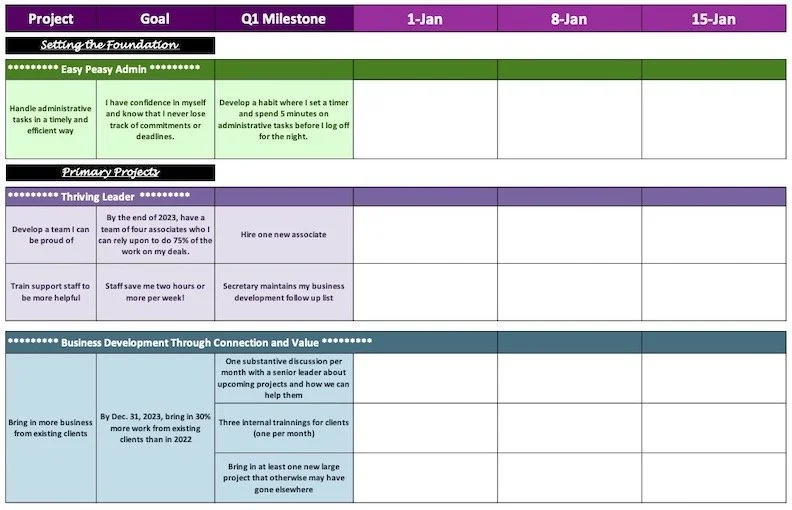A Yearly Planning Structure to Support You in Achieving Your Goals for 2023!
/Happy New Year! May you have joy, success and satisfaction in 2023!
This time of year, many of us are feeling inspired, setting goals and planning for the coming year. The challenge is to harness this energy so that we actually fulfill those goals. Over the years, I have developed a tool that I use myself and with clients for the purpose of planning, tracking projects and maintaining momentum throughout the year. And this year, I have decided to share it with all of you.
If the thought of planning for the coming year just feels too overwhelming, I completely understand. Each year I meet with a group of friends for a new year “visioning party.” We talk about how the previous year went and share our visions and plans for the coming year. Last year, for the first time ever, several of us felt incapable of planning. In my case, my mother had just had a stroke and I was exhausted from constant hospital visits and trying to figure out next steps. One friend was dealing with a major medical crisis. Another had lost her job under traumatic circumstances and was struggling with a difficult job search. All in all, about half of us didn’t feel ready to create plans for the year. If you are in that space, for whatever reason, I invite you to be kind to yourself and to recognize that this is the ebb and flow of life. We can’t always be in go-go-go powerful action mode. When you have recovered from the crisis, your motivation and joie de vivre will return, and that will be a perfect time for strategy, planning and inspiration.
For the rest of you, those with goals or aspirations for the year, this is a tool to help keep track of those goals and bring them to fruition. I’m going to explain (1) Reasons why the yearly planning structure is so effective, (2) General guidelines for using the yearly planning Structure, and (3) What to put in each box. However, you can just feel free to skip all that and download it here.
The download I am providing includes three tabs. The first provides an example. The other two tabs are blank. (One is for professional projects and the other is for personal.) This document feels simple when you are actually using it. But explaining it can make it seem rather more complicated. Please feel free to take what you like and ignore, change (or delete) the rest.
This is an example of what it looks like when it is filled out:
Reasons Why the Yearly Planning Structure is So Effective
This yearly planning document provides a structure that supports you in achieving your objectives in several different ways:
Looking at the Big Picture/Expanding the Time Horizon – When thinking about our goals, most of us focus on the things we want to fix in our lives NOW and the time horizons tend to be short, just a few weeks or months. While short-term plans are useful and important, it is also helpful to think long-term. What do you really want in your life and your career? Significant projects often require longer time horizons. Of course, such planning can be done at any time, but the new year tends to feel like an auspicious time for big picture thinking.
Prioritizing/Thinking Strategically – There are numerous tools for planning individual projects. While those are exceedingly useful, this tool is intended to help you think through what is appropriate and feasible overall in your life and work. By putting projects all in one document and by identifying some quarterly milestones, it helps you to think through timing and priorities. Most of us tend to be excessively optimistic regarding what can be done in the next month or so and this sets us up for failure, especially if we are trying to do multiple projects simultaneously. By looking at your goals/projects all together you are better able to prioritize and figure out appropriate pacing. Also, some activities are better done in one season or another and this allows you to think through and account for those factors.
Projects Remain at the Forefront – Who hasn’t had goals fall by the wayside? We get so excited at the beginning of the year and then life is busy or projects don’t proceed as we hoped and the projects fall off the radar. While you can of course revise the projects or change them entirely, having a document that you look at regularly, helps you to stay on track with your goals.
Acknowledging Progress – Many of us tend to be hard on ourselves and discount our own progress. This spreadsheet is designed to include places for weekly updates. Most goals take time to achieve. When we write out the actions we took or progress we achieved, it is a way of giving ourselves the recognition that we need to help us stay motivated and focused.
Clearing the mind – Our minds are very busy. Writing things down helps to declutter our minds. This allows us to fully focus and be more creative or efficient with whatever we are working on at the moment. Once you establish the habit of checking on the projects regularly, you can relax knowing that you won’t forget about them and you will return to those goals when you are able.
Clarity – Writing out projects, even in a simple way, makes us think through them more thoroughly and thus makes the plans better and more likely to succeed.
Guidelines for Using the Yearly Planning Structure
Number of Projects/Organizing the Projects
Although one can accomplish a great deal in the course of a year, it is very easy to feel overwhelmed looking at a list of 10 or 12 “projects.” It can feel disempowering to look at what essentially turns into a never-ending to-do list. For most of us, 3-5 projects are the most we can realistically address concurrently. Given all of your big dreams and enthusiastic ideas for the year, that may seem too limiting, but keep in mind that people’s projects typically represent only a tiny fraction of what they do on a daily basis. Narrowing your projects down to 3-5 is good practice in terms of prioritizing and strategic planning. A “strategy” that includes everything is not actually a strategy. It is an impractical hodgepodge. This is true for individuals as much as for organizations. Under the Professional Goals tab of the spreadsheet, you will see that the projects have been divided into four categories (1) Setting the Foundation (2) Primary Projects (3) Other Projects, and (4) On Hold.
Setting the Foundation – This would be for projects that are about enhancing your well-being or productivity. Working on these projects makes everything else easier.
Primary Goals – These would be the goals — three or fewer — that you are focusing on currently. This may change over the course of the year as you complete certain projects, establish new habits or as circumstances change.
Other Goals – These are the goals or projects that you want to keep on your radar but that you are choosing to deprioritize. You may not have time for them, and if so, that is fine. It can also be helpful to include in this category a project that you particularly want to give yourself credit for when you take actions. For example, if you tend to feel uncomfortable with networking and want to encourage yourself to do it more, you could create a project where the goal is to have two networking lunches per month. Then any action you take—reaching out to someone to ask if they want to get lunch, scheduling a lunch, actually having a networking lunch—you can write that down as an accomplishment.
On Hold – These are the projects that you would like to get to sometime this year but now is not the right time, either because of your current capacity or because it is not the right time of year for this activity. This can also be a placeholder for projects that you don’t want to forget about but that realistically you know you will not have time for this year.
Sub-Projects
For more complex or multifaceted projects, you may want to include several sub-projects under one general project heading. For example, one of my clients has a project called “Dream Team” that includes four sub projects. One sub-project is to hire two more associates. Two of the sub-projects are about supporting specific associates to develop certain skills and the fourth sub-project is about the way work is distributed in her practice group. Sub-projects enable you to track different elements of a project while at the same time keeping it under one “roof.” Most people find that this makes the project feel more manageable while still enabling them to keep track of the different elements.
Personal and Professional
The spreadsheet I’m providing has a tab for personal projects and another for professional projects. That way you can have a few projects in each category without needing to look at too many at once.
Colors
Many people enjoy having bright colors and like to select colors that feel appropriate to each project. That is why I included so many. They are just there for fun and to provide some options. I strongly advise against making a project for each color because that would be way too many projects for one person to manage.
What to Put in Each Box
Project Name
This goes in the darker colored bars, where it says ******** Project Name ********. It is not necessary to name the project but I find that an inspiring project name helps to maintain motivation. Calling a project “business development pipeline” makes it seem like drudgery but calling it “Connection and Contribution” may seem more enticing. “Staff performance improvement plan” may feel burdensome whereas “Dream Team” may leave you feeling inspired and excited.
Project
The projects column is where you can put a general description of the project or sub-project. It could be a short phrase that sums up the goal like “Bring in more business from existing clients.” It could also be a longer-term project that may not be achievable in a single year, such as “make partner.”
Goal
Usually, you will use this box for a specific measurable goal that includes a deadline. For example, “By the end of 2023, have a team of four associates who I can rely upon to do 75% of the work on my deals.” If you have a long-term goal that may take several years, you will want to choose an intermediate goal that can be achieved within 12 months or less. For most projects, it is helpful to make the goal as concrete as possible. However, there are exceptions. For some goals, it can be helpful to focus on the experience that you hope for from the project. For example, “I have confidence in myself and know that I never lose track of commitments or deadlines.” Please note that for these “fuzzier” goals you will still want to identify some concrete action steps under the milestones.
Quarterly Milestones
It can be helpful to split projects up into stages. It can feel daunting to think about engaging with all the elements of a big project all at once. By splitting it up into milestones, you are able to focus on one piece at a time, which makes it seem more manageable. Of course, not every project is conducive to milestones, or you may find that you have essentially the same milestone for each quarter.
Accountability Through Weekly Updates
There are columns for each week of the year, starting with January 1. In these columns, you can provide weekly updates on progress or accomplishments from that week. The intention is for you to practice celebrating your wins and stay aware of the projects. If you tend to be hard on yourself, it is particularly important to focus on what you have accomplished that week. Try to keep your expectations of yourself reasonable and GIVE YOURSELF CREDIT for everything you do. If you haven’t written any updates for a month, just update to the best of your memory and congratulate yourself for doing it now. Or just delete the columns for the weeks that you skipped and move on. Most people make goals and then completely ignore them. If you are keeping the goals in mind and moving them forward periodically throughout the year, you are doing much better than most. If you were in trial for the last month or your whole family has been ill, of course you haven’t worked on the projects. Just maintaining your life probably takes 90% of your energy, even in ordinary circumstances. You really deserve lots of credit for anything extra you may be doing. One of the benefits of writing these weekly updates for yourself is that at the end of the year you can look back and see the progress you have made throughout the year.
Final Notes
Does this Structure Work?
As with any accountability, planning or support structure, the only useful standard is whether the tool is helpful. Does it help you to stay motivated and on track with your projects? Does it help you to clear your head or get your thoughts in order? Does it help you to prioritize and set manageable goals? Does it help you to celebrate your wins? Most people who try it find that it is helpful in these areas. I hope you like it! If you haven’t downloaded it already, here is the link again.
Practical Usage Notes
The template spreadsheet is set up using “freeze frame” such that the top row, as well as the first three columns remain visible. Thinking about the entirety of a project can feel overwhelming. So, this allows you to focus on one milestone at a time. As you add in weekly updates you can scroll to the right while still keeping the projects visible. When the second quarter rolls around you just go to the view tab and “unfreeze frames”. Then click on the second cell down under Q3 Milestone and “freeze frames”. This will return it to the same set up as before except now the Q2 Milestones will be visible.
And of course, while I’m calling it a yearly planning document, it can, of course, be used at any point throughout the year. Let me know how it goes!







